Signs of red pigment were spotted in a fossil for the first time
The 3-million-year-old mouse was reddish-brown on its back and sides

LIVING COLOR A 3-million-year-old fossil of a field mouse (left) had patches of reddish-brown fur on its back and sides. X-ray spectroscopy revealed patches of reddish pigment (yellow regions, at right) in the ancient rodent.
P.L. Manning et al/Nature Communications 2019







